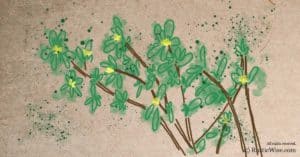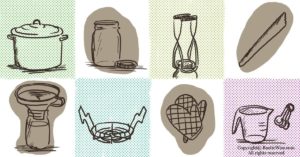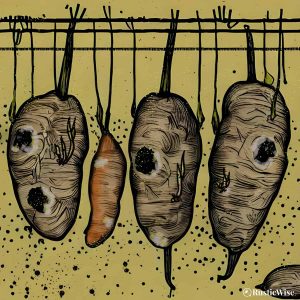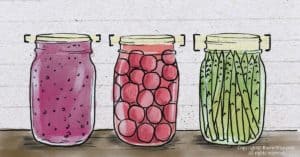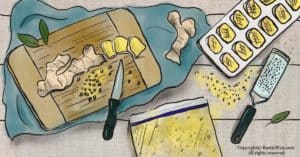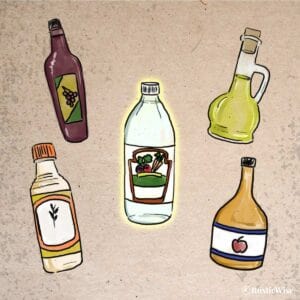How to Prepare Plantain Leaves for Medicinal Uses
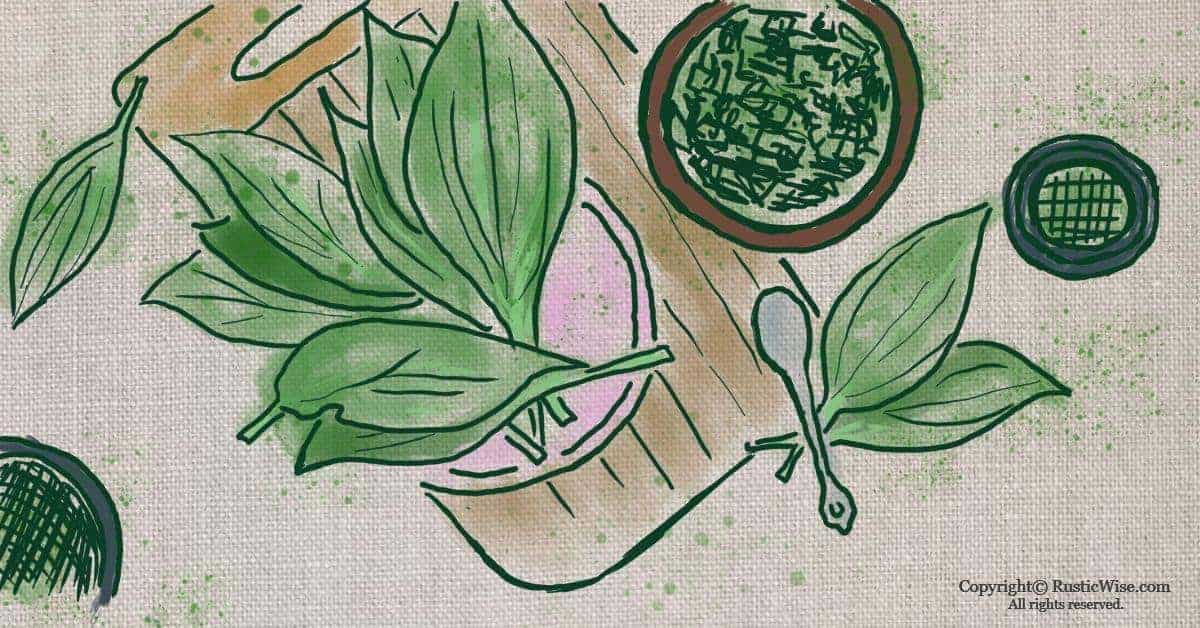
Broadleaf plantain has long been used in traditional medicine. It’s found all around the world and is a resilient perennial plant that pops up year after year. And best of all, it’s free.
Not to be confused with the tasty fruit plantain, broadleaf plantain (Plantago major) is its own separate species. It also goes by several other names such as: greater plantain, common plantain, snakeweed, and white man’s foot.
Note: I am not a herbalist, naturopath, or doctor. As with any wild weed or foraged plants, please use at your own discretion. If you have any underlying health issues, please see a doctor.
Plantain medicinal uses
The broadleaf plantain has many medical properties (antibacterial , astringent, and diuretic just to name a few). Learning how to prepare plantain leaves for medicinal uses is a valuable skill that comes in handy if you ever find yourself in a survival situation. It’s used to heal and treat many skin and body ailments including:
- Mosquito bites, insect bites, stings.
- Mild poisonous snake bites.
- Poison ivy.
- Minor wounds (vitamin K helps blood clot to heal wounds).
- Reduces fever and headaches.
- Tones and smoothes skin.
- Regulates bodily functions and secretions.
- Cold and cough symptoms.
- Sunburn.
- Eczema.
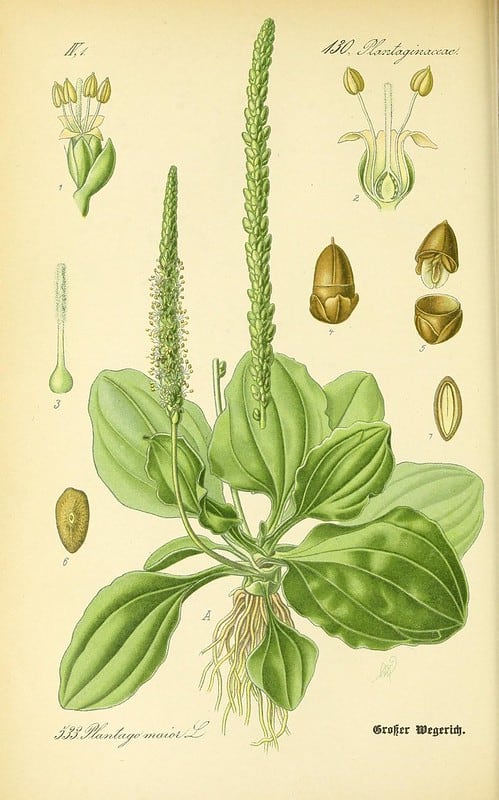
Credit: Biodiversity Heritage Library / Flickr, n331_w1150
Plantain leaf side effects
As with other herbal remedies, it’s best to use plantain in moderation.
If you have sensitive skin, or are prone to allergies, be careful when applying plantain leaves directly to skin. Try applying plantain to a small area first. For most adults, it’s safe to ingest by mouth.
Too much plantain can cause diarrhea, or affect blood pressure. If you have intestinal or abdominal issues, avoid using plantain.
Plantain contains large amounts of vitamin K which helps blood to clot to heal wounds. If you are on a medication like Warfarin (Coumadin) that slows blood clotting, do not use plantain as it will decrease the effectiveness of your medication.
Do not use broadleaf plantain if you are pregnant or breastfeeding.
A note on harvesting plantain leaves
Broadleaf plantain thrives in areas where there’s human disturbance—along sidewalks, roads, and on lawns. Since herbicides and pesticides are often used, be careful about harvesting plantain leaves in areas you’re unfamiliar with.
Plants that are treated with herbicide have wilted leaves and often have discolored spots or patches. It’s best to harvest plantain leaves from your own garden or yard, or a place you know to be free of harmful chemicals.
If you don’t have a garden or lawn of your own, consider asking a neighbor or friend if you could help them “pull a few weeds.” They’ll probably be more than happy to oblige! They might be curious and want to join you on your foraging adventure.
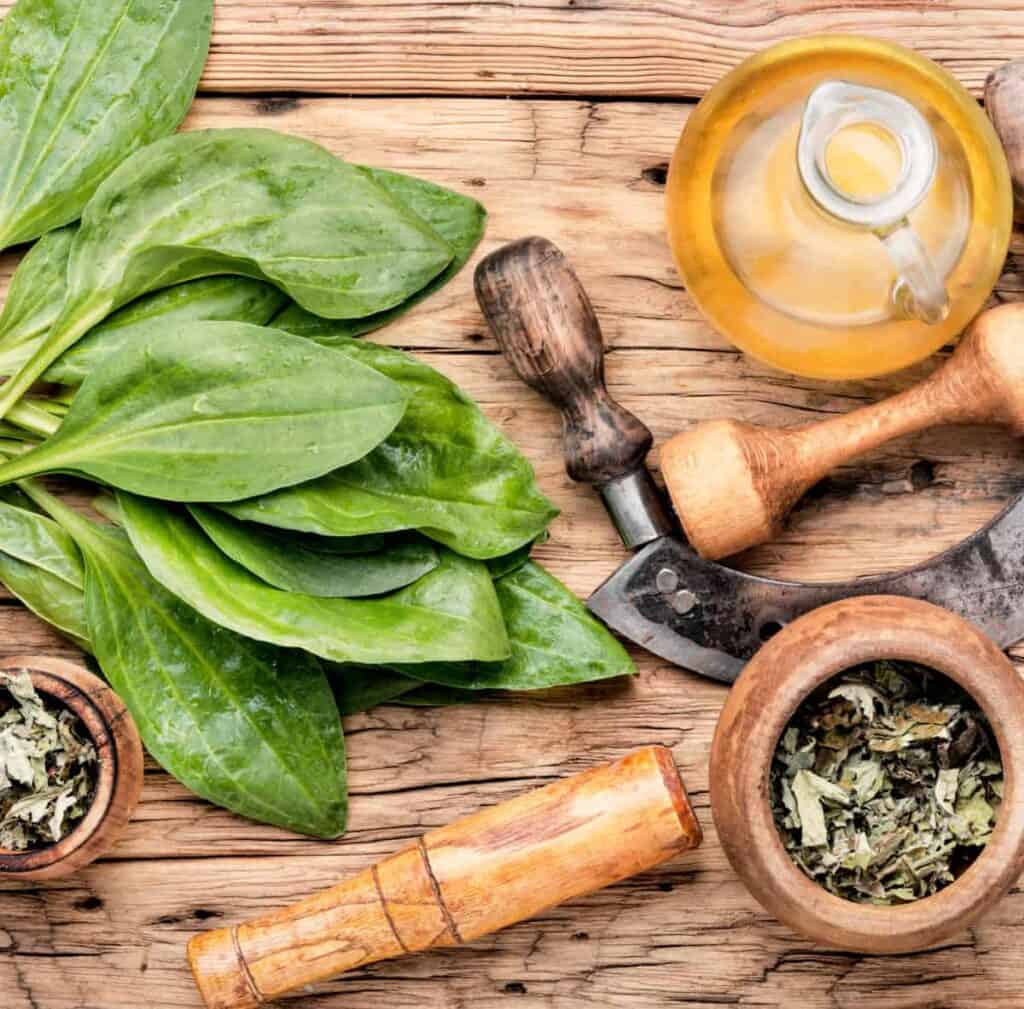
Credit: Vector State
How to prepare plantain leaves for medicinal uses: fresh leaves
Using fresh plantain leaves is one of the quickest and easiest ways to take advantage of its natural healing powers. The leaves come off easily leaving the roots in the ground for regrowth.
Plantain poultice
One of the most common ways to use plantain leaves is to make a fresh plantain poultice. Make a plantain poultice to treat a variety of insect bites, stings and even mild poisonous snake bites (hence its nickname, snakeweed).
To make a saliva-based poultice, simply chew up a few leaves into a mash and apply directly to the wounded area. You can use a bandage to secure the poultice in place. If you don’t have a bandage handy, try wrapping another plantain leaf around.
While you might be grossed out by making a “spit” poultice, your saliva’s enzymes actually have healing properties that speed up the healing process. It’s best if the person with the wound is chewing his or her own leaves. If you really don’t want to chew plantain leaves, you can try grinding and mashing leaves between two rocks.
The plantain poultice should be larger than the size of the wound (it should more than cover the surface area). Leave the poultice on for at least one hour. For more severe ailments, leave on for two to four hours, or overnight as necessary.
Apply a fresh plantain poultice several times a day until symptoms improve.
How to make plantain leaf tea
You can use fresh or dried plantain leaves can to create a healing herbal tea. Plantain leaf tea is used as a herbal remedy for cold and cough. Sweeten with honey as plantain has a strong, sometimes bitter flavor.
Cooled plantain leaf tea can also be used as a natural DIY beauty treatment to tone and smooth your face and also to treat sunburn. Use a spray bottle to spritz on cooled plantain leaf tea to affected areas.
While it’s best fresh, keep any unused plantain leaf tea in the fridge —it should be good for several days.
To make plantain leaf tea, grab a generous handful of fresh plantain leaves and give them a quick rinse. (No need to do this if you’re using dried leaves!)
If using dried leaves, use one teaspoon to each cup of water. If using fresh leaves, use roughly one tablespoon to each cup of water. Add the leaves to water and bring to a boil. Turn off heat and steep plantain leaf for about 5 to 10 minutes. Use a strainer to remove leaves.
If you’re using plantain tea for cold and cough, drink while it’s warm between three to six times/day.
How to make plantain-infused oil
You might prefer to use the healing properties of plantain as oil, because, let’s face it, we don’t always have fresh plantain leaves lying around. Plantain-infused oil is used as a base to make other salves, balms, and tinctures.
When making plantain-infused oil, there’s some debate as to whether to use fresh or dried leaves. While fresh leaf recipes skip the step of drying, there’s a possibility of mold growing. For this reason, let’s stick to dried leaves!
Drying leaves isn’t as tedious as it sounds. Start by laying clean, fresh leaves onto paper towels, clean dish towels or drying screens. Or, you might prefer to bundle them to hang if you’re short on counterspace. Your leaves should be dry in a few days. They should feel brittle or paper-like.
Keep your batch of DIY plantain-infused oil in a dark, cool place. It keeps up to one year. To make plantain-infused oil, there’s a slower, old-school way, or a quick way:
Old-school method
Gather a few glass mason jars to store your oil. Fill each jar half-full with dried leaves (crumble them a bit if there are any large pieces). Fill the remainder of the jar with your choice of carrier oil. Choose a good quality olive oil, or sunflower oil. Cover the jar and let it sit for four to six weeks in a dark place like a pantry or cupboard. Gently shake and swirl the jars periodically. Strain the leaves.
To kick start the infusion, some people let the jars sit in a window where the sun can warm it for a few days before placing it back into the pantry.
Quick(er) method
Pressed for time? No worries. Place your filled, closed jars into a saucepan filled with a few inches of water. Heat on low for a few hours. You might need to add more water as it evaporates. Keep a warm kettle nearby to top up your saucepan as needed. Strain leaves and let cool before storing.
Make sure you label your jars with its contents and date, or you’ll have a pantry full of jars filled with mysterious liquids!
Conclusion
Broadleaf plantain leaves are a great source of nutrients and medicinal healing properties. Go outside, gather some leaves, and incorporate this healthy plant into your regular routine.
👉If you like this post, see our Timeless Guide To Foraging for Wild Food.
Would you like more timeless tips via email?
Fun tips to help you live an independent, self-sustaining lifestyle. Opt-out at any time.


References:
- WebMD, Great Plantain, Side Effects & Safety: https://www.webmd.com/vitamins/ai/ingredientmono-677/great-plantain. Accessed March 2020.
- Canadian Wildlife Federation, Broadleaf Plantain (Plantago major). https://cwf-fcf.org/en/explore/gardening-for-wildlife/plants/edibles/edible-wild-and-not-so-wild-plants/plantain.html. Accessed March 2020.
- Invasive Species Compendium, Plantain Fact Sheet: https://www.cabi.org/isc/datasheet/41814. Accessed March 2020.
- Drugs.com, Plantain, https://www.drugs.com/npc/plantain.html. Accessed March 2020.
- The Nerdy Farmwife, 10 Things to Make with Plantain: https://thenerdyfarmwife.com/10-things-to-make-with-plantain/. Accessed March 2020.

Author: Josh Tesolin
Josh is co-founder of RusticWise. When he’s not tinkering in the garden, or fixing something around the house, you can find him working on a vast array of random side projects.


